Pink eye, medically known as conjunctivitis, is one of the most common eye conditions worldwide. While it is often thought of as a minor irritation, the reality is that pink eye has a surprisingly large impact on schools, workplaces, and healthcare systems across the United States and the globe. From contagious outbreaks to rising healthcare costs, conjunctivitis is more than just a temporary inconvenience—it’s a public health concern that deserves attention.

What Is Pink Eye?
Pink eye occurs when the conjunctiva—the clear tissue covering the white part of the eye and inside of the eyelid—becomes inflamed. Common causes include:
-
Viral infections (highly contagious, especially adenoviruses)
-
Bacterial infections (such as staph or strep bacteria)
-
Allergies (pollen, dust, mold, pet dander)
-
Environmental irritants (smoke, chemicals, chlorine)
Symptoms include redness, itchiness, watery or sticky discharge, swollen eyelids, and light sensitivity. While bacterial conjunctivitis can be treated with antibiotics, viral pink eye typically needs to run its course.
Pink Eye in the United States
In the U.S., millions of pink eye cases occur each year, making it one of the top reasons for eye-related doctor visits. The impact includes:
-
Lost productivity: Students are sent home from school, and parents often miss work to care for them.
-
Healthcare costs: Medical visits, prescription eye drops, and over-the-counter remedies add to annual expenses.
-
School outbreaks: Daycares, classrooms, and sports teams are common hot spots due to close contact.
Because pink eye spreads so easily, a single case can quickly affect an entire classroom or office.

The Global Impact of Conjunctivitis
Beyond America, pink eye has a broad reach. In low- and middle-income countries, lack of access to proper healthcare can lead to untreated cases and complications. Factors like limited sanitation, overcrowding, and shortages of medical supplies contribute to higher infection rates.
For example:
-
In parts of Africa and Asia, large-scale outbreaks have disrupted schools and workplaces.
-
According to the World Health Organization (WHO), viral pink eye outbreaks can affect thousands of people at once, especially in densely populated areas.
-
In regions with limited healthcare infrastructure, pink eye can progress into more severe conditions if left untreated.
Why Pink Eye Matters: Economic and Social Effects
Although often labeled a “minor illness,” pink eye has ripple effects:
-
Educational setbacks: Children miss school days and fall behind in lessons.
-
Workforce disruption: Adults missing work lowers productivity and can affect businesses.
-
Strain on healthcare systems: Large outbreaks overwhelm clinics, especially in underserved communities.
This makes pink eye more than just a personal health issue—it’s a community-wide concern.
How to Prevent the Spread of Pink Eye
The good news is that conjunctivitis is highly preventable with proper hygiene practices. Some of the most effective methods include:
-
Wash hands frequently with soap and water.
-
Avoid touching or rubbing the eyes.
-
Disinfect shared surfaces such as keyboards, doorknobs, and desks.
-
Do not share towels, makeup, or contact lenses.
-
Stay home if you have contagious pink eye to prevent spreading it further.
Final Thoughts
Pink eye may not be life-threatening, but its impact across America and the rest of the globe is undeniable. It disrupts schools, lowers workplace productivity, and strains healthcare systems. By raising awareness, improving sanitation, and practicing preventive measures, communities can reduce the spread of conjunctivitis and minimize its global burden.
